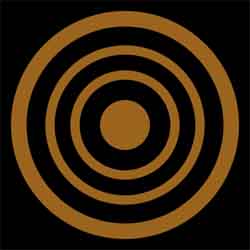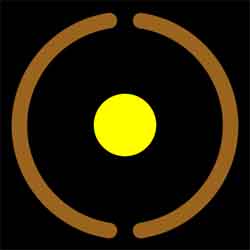Early History
In ancient times, the idea of subterranean realms seemed arguable, and became intertwined with the concept of “places” such as the Greek Hades, the Nordic svartalfheim, the Christian Hell, and the Jewish Sheol (with details describing inner Earth in Kabalistic literature, such as the Zohar and Hesed L’Avraham).
Edmond Halley in 1692 put forth the idea of Earth consisting of a hollow shell about 800 km (500 miles) thick, two inner concentric shells and an innermost core, about the diameters of the planets Venus, Mars, and Mercury. Atmospheres separate these shells, and each shell has its own magnetic poles. The spheres rotate at different speeds. Halley proposed this scheme in order to explain anomalous compass readings. He envisaged the atmosphere inside as luminous (and possibly inhabited) and speculated that escaping gas caused the Aurora Borealis.
De Camp and Ley have claimed (in their Lands Beyond) that Leonhard Euler also proposed a hollow-Earth idea, getting rid of multiple shells and postulating an interior sun 1000 km (600 miles) across to provide light to advanced inner-Earth civilization (but they provide no references). However in his Letters to a German princess Euler describes a thought experiment involving a patently solid Earth.
De Camp and Ley also claim that Sir John Leslie expanded on Euler’s idea, suggesting two central suns named Pluto and Proserpine (this was unrelated to the dwarf planet Pluto, which was discovered and named some time later). Leslie did propose a hollow Earth in his 1829 Elements of Natural Philosophy (pp. 449Ð453), but does not mention interior suns.
19th century
In 1818, John Cleves Symmes, Jr. suggested that the Earth consisted of a hollow shell about 1300 km (800 miles) thick, with openings about 2300 km (1400 miles) across at both poles with 4 inner shells each open at the poles. Symmes became the most famous of the early Hollow Earth proponents. He proposed making an expedition to the North Pole hole, thanks to efforts of one of his followers, James McBride, but the new President of the United States, Andrew Jackson, halted the attempt.
Jeremiah Reynolds also delivered lectures on the “Hollow Earth” and argued for an expedition. Reynolds went on an expedition to Antarctica himself but missed joining the Great U.S. Exploring Expedition of 1838-1842, even though that venture was a result of his agitation.
Though Symmes himself never wrote a book about his ideas, several authors published works discussing his ideas. McBride wrote Symmes’ Theory of Concentric Spheres in 1826. It appears that Reynolds has an article that appeared as a separate booklet in 1827: Remarks of Symmes’ Theory Which Appeared in the American Quarterly Review.
In 1868, a professor W.F. Lyons published The Hollow Globe which put forth a Symmes-like Hollow Earth hypothesis, but didn’t mention Symmes. Symmes’s son Americus then published The Symmes’ Theory of Concentric Spheres to set the record straight.

